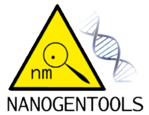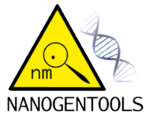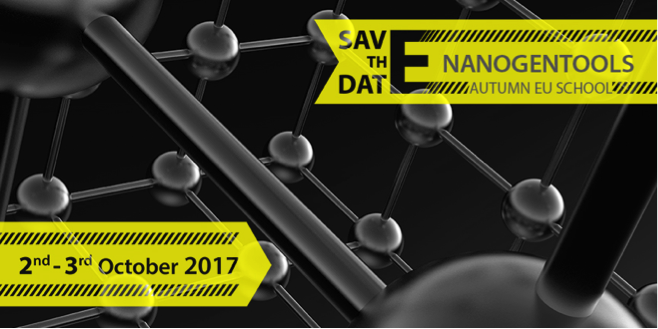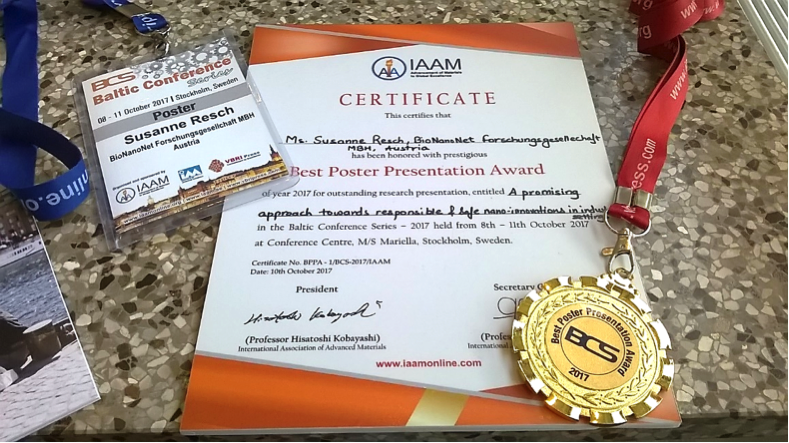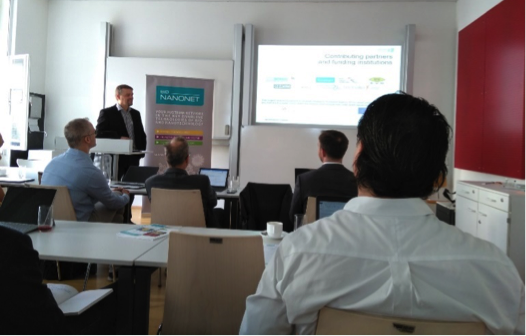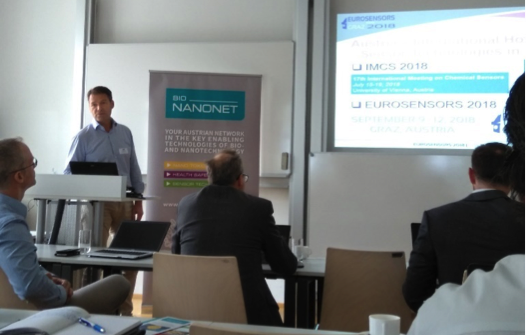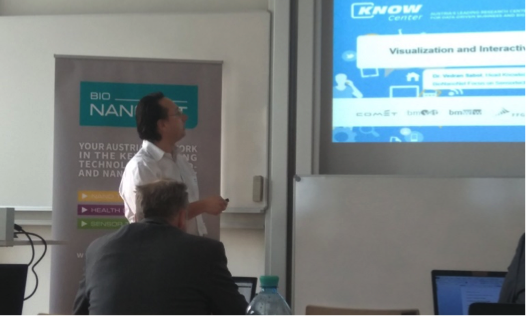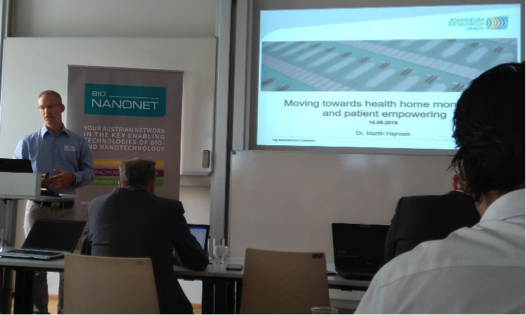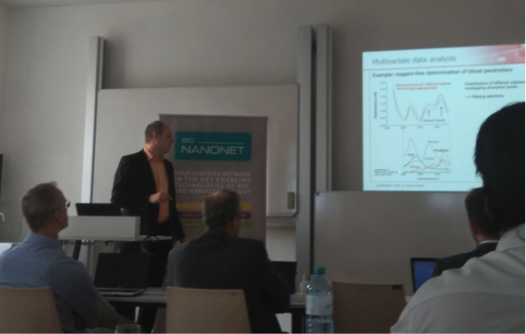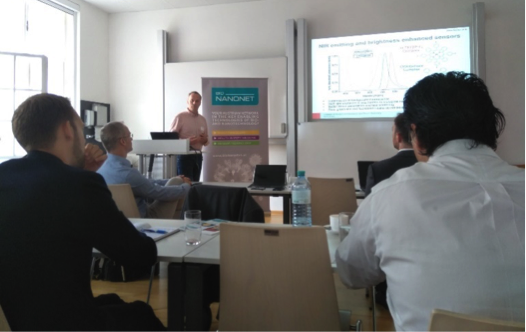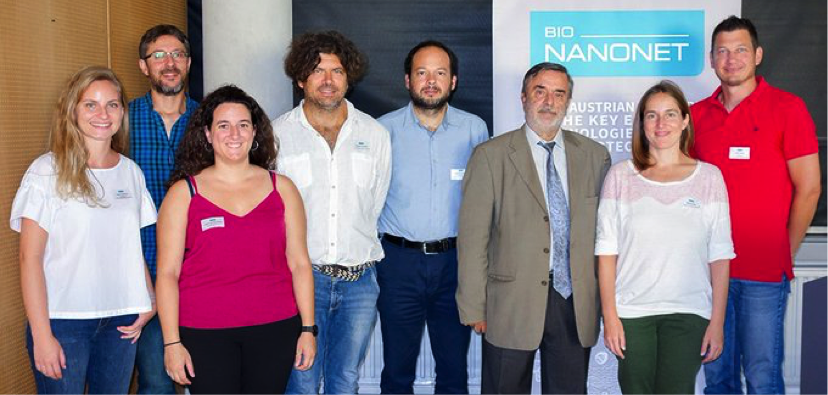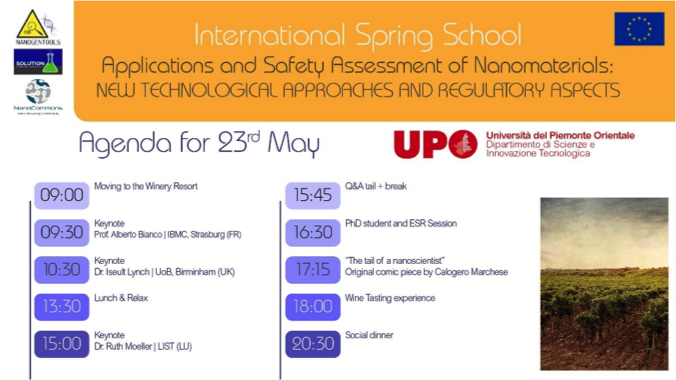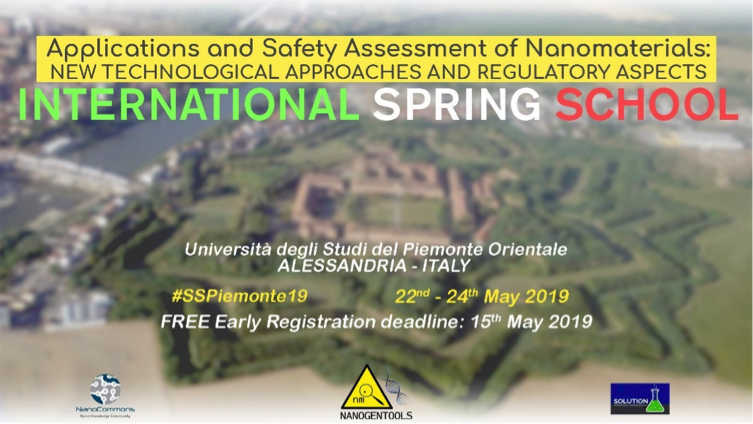One of the most important goals of the project will be to begin training workers with a high level of knowledge in an area, nanosafety, that will be necessary for the future of European industry, and that will ensure its competitiveness in many sectors: automotive, textile, packaging products, construction/building and transportation products, decoration interior and exterior, air purification, decontamination, etc.
Safe By Design
A number of H2020 funded projects are working on various aspects of the Safe-by-Design (SbD) concept and all rely upon industry to understand its meaning and how to use the tools being developed in these projects. Disseminating this knowledge to a wider audience will help in the acceptance and uptake of SbD by companies and will also allow the projects to learn more about stakeholder needs.
A workshop that allows knowledge exchange between various SbD projects as well as listening and learning from different stakeholder groups (industry, academia, regulators, insurance, consumers) can help adjusting research, dissemination and exploitation strategies accordingly. This ensures project outcomes and tools are relevant long after the project has officially concluded.
Executive Summary
Complete name of the event: Nanomaterials: Industrial Workshop on Safe-By-Design
Type of event: Workshop
Dates: 24-25 April 2017
Place: Gaiker Centro tecnológico, Bilbao (Spain)
Lead Organiser: Nanotechnology Industries Association (NIA)
Organizing Committee / Participants: Nanogentools, caLIBRAte, EC4SafeNano, NanoFASE, NanoMILE, NanoReg2, ProSafe
Participation: Limited, by web form. Free entrance.
Target Groups:
- Technical development experts from industry (i.e. from the companies involved in running Pilot-line projects)
- (nano)Safety-experts from industry and research (i.e. nanosafety-responsible persons from Pilot-line projects
- SbD-experts
Web:
Main Objectives
- Introduction of the Safe-By Design concepts to a wider audience.
- Development of new relationships between the Horizon 2020 projects involved
in Safe-By-Design and industrial stakeholders. - Bringing together industrial companies who can benefit from the use of
Safe-By-Design.
Save The Date
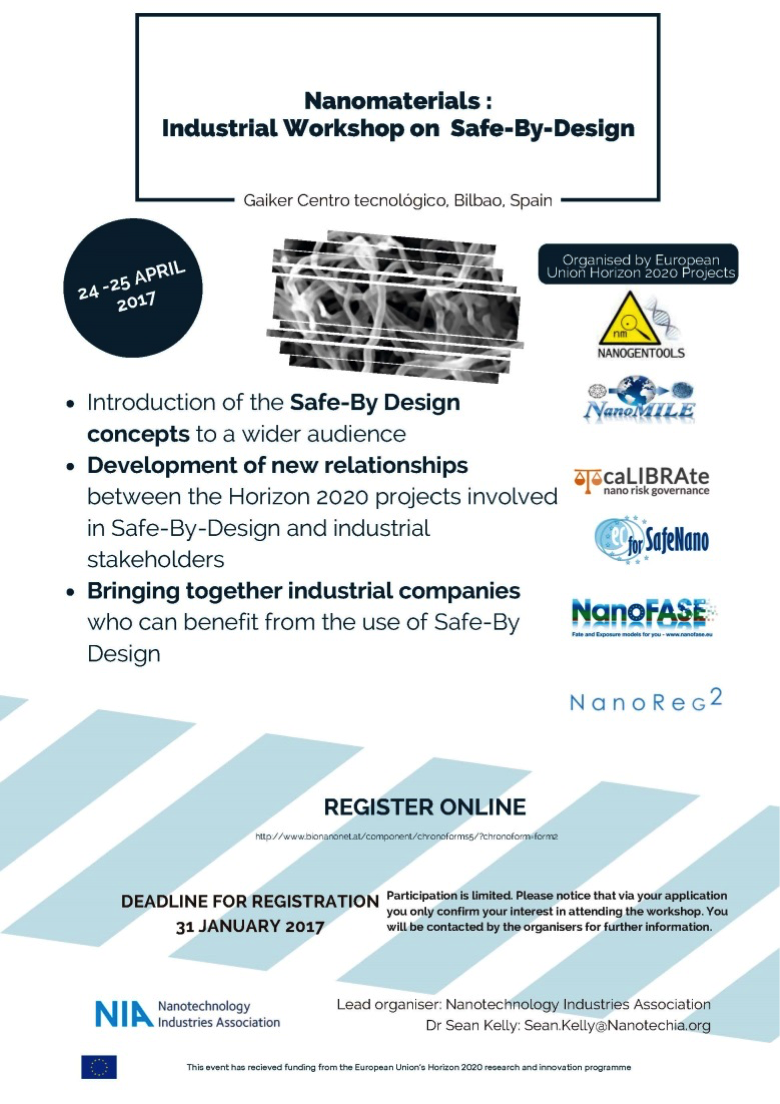
Agenda
Bibliography
Nanomaterials: Industrial Workshop on Safe-by-Design
Nanotechnology Round Table


Nanotechnology is the basis for the next industrial revolution. Nanotechnology is everywhere, in our clothing, cars, windows, computer and displays, even in our cosmetics and medicine adding new functionalities, intelligence, integrations, portability and networking capability in many new products with high market potential. Nanotechnology is the key to markets worth billions of dollars annually.
Nanotechnology helps Europe to address global challenges such as climate change, constraints in energy production and shortage of resources, insufficient access to clean water and food safety, as well as widespread diseases and affordable health care worldwide.
Many regions are interested in developing nanotechnologies technologies with the sector attracting the most interest being the development of next generation nanomaterials, nanodevices and nanosystems. The cross-cutting and enabling materials technologies and material development and transformation and sustainable (low-carbon) material energy solutions are the categories where regions indicated most priorities.
For industrial biotechnology, regions indicate priorities mostly related to biotechnologies as an innovation driver and biotech based industrial processes. Concerning the latter, priorities were cited most often concerning agro-food, food safety, biomaterials and cosmetics. Some Regions indicate priorities related to photonics, mostly related to lasers and photonic sensors. Several regions signal interest in possible combinations with micro-and nanoelectronics; a number of regions indicated that the rise of digital electronics and photonics has potential to impact on a range of industries and they will be exploiting photonics as an enabling technology in a horizontal fashion in their RIS3.
Nonetheless, the use of nanomaterials also raises safety concerns, which need to be addressed in a Europe-wide regulatory context. EU regulations on consumer products such as food, cosmetics and biocides have specific provisions for nanomaterials. Such provisions for nanomaterials, e.g. ingredient labelling, have to be based on a regular definition of the term ‘nanomaterial’.
Executive Summary
Complete name of the event: Nanotechnology Round Table
Type of event: Meeting
Dates: 30 May 2017
Place: ERRIN, Brussels (Belgium)
Lead Organiser: ERRIN
Organizing Committee / Participants: NIA, ICCRAM, NANOfutures
Participation: Closed.
Web:
Main Objetives
- To discuss current thinking and regional interest in nanotechnologies
- To develop possible themes and dates for future ‘nano’ events under the ERRIN Advanced Manufacturing Working Group
- To examine specific areas of interest such as nano-safety
Agenda
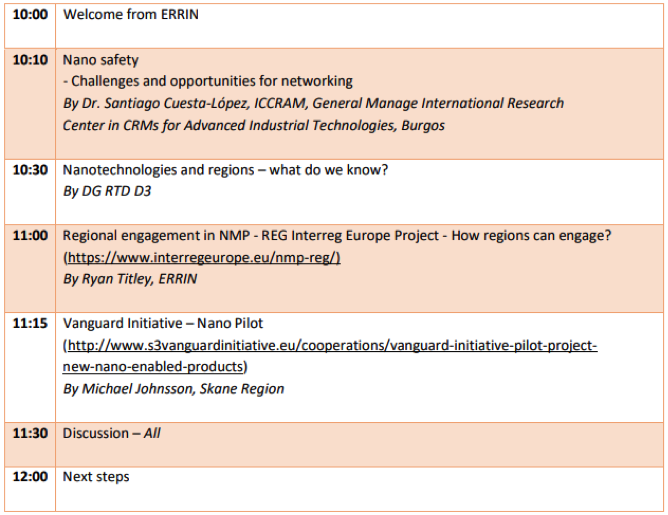
Bibliography
http://ec.europa.eu/research/index.cfm?pg=events&eventcode=561FD004-C1CC-1B6B20F005541185BC34
Autumn School

NanoMaterials safety is of great societal concern and raises many questions for the general public, governments, industry, scientists and regulators. Identifying and controlling the hazards associated with NMs is required to ensure the safety in parallel to exploiting the technological benefits. NANOGENTOOLS answers this challenge by creating a collaborative excellence-based knowledge exchange network that will:
- push forward knowledge via method development and pre-validation,
- train scientists in new methodologies to assess long term nanosafety, and
- support their inclusion in standardization and EU regulations.
NANOGENTOOLS combines toxicogenomics, proteomics, biophysics, molecular modeling, chemistry, bio/chemoinformatics to develop fast in vitro high throughput (HTS) assays, with molecular based computational models for nanotoxicity. Its objectives are to:
- Provide solutions for faster, more reliable assessment of NM toxicity and propose HTS and omics tools for predicting toxicological properties of NMs.
- Develop new bioinformatics methodologies for analyzing -omics data and create an open database in collaboration with the EU Nanosafety Cluster.
- Conduct research and training on biophysical techniques and mathematical models for accurate and fast nanotoxicity prediction.
- Build/improve the safe by design concept, demonstrated using carbon-NMs and nanosensors.
- Place our new knowledge in the context of regulations and EU roadmaps. NANOGENTOOLS brings together cutting edge research, innovative knowledge-transfer and codevelopment, and cross-sectoral and cross-disciplinary secondments linking EU academic institutes/networks with industry and policy makers across 8 countries.
 Expected impacts include pre-validated tools for efficient cost-effective nanosafety assessment applicable to SMEs for incorporation into regulatory frameworks, and translation of knowledge via development of a CNT-based nanosensor based on safe-by-design principles.
Expected impacts include pre-validated tools for efficient cost-effective nanosafety assessment applicable to SMEs for incorporation into regulatory frameworks, and translation of knowledge via development of a CNT-based nanosensor based on safe-by-design principles.
Executive Summary
Complete name of the event: Autumn EU School “Advanced Training in understanding the safety of nanomaterials”
Type of event: Workshop
Dates: 2-3 October 2017
Place: Hotel Rice Palacio de los Blasones, Burgos (Spain)
Lead Organiser: ICCRAM – UBU
Organizing Committee / Participants: University of Birmingham, NIA, BioNanoNet, NanothinX, Sitex45, Università Del Piamonte Orientale, Novamechanics
Participation: Open & Free entrance.
Web:
http://www3.ubu.es/iccram/nanogentools-eu-school/
Main Objetives
- Awake the curiosity of young researchers in the related subject.
- Create a creative, intergenerational forum to discuss the development of nanoscience and its implications on human and environmental health.
- Highlight the advantages of MSCA RISE perspective, showing the main hits gathered in the frame of the project thanks to the potential of interinstitutional cooperation.
- Discuss the need of regulation and safety for the 21th Century generation of Nanotech-based products and materials.
- Train the next generations in advanced techniques for nanosafety assessment, guiding them into the key concept of “Safe by Design”.
Save the Date
http://www3.ubu.es/iccram/nanogentools/save-the-date/
Agenda
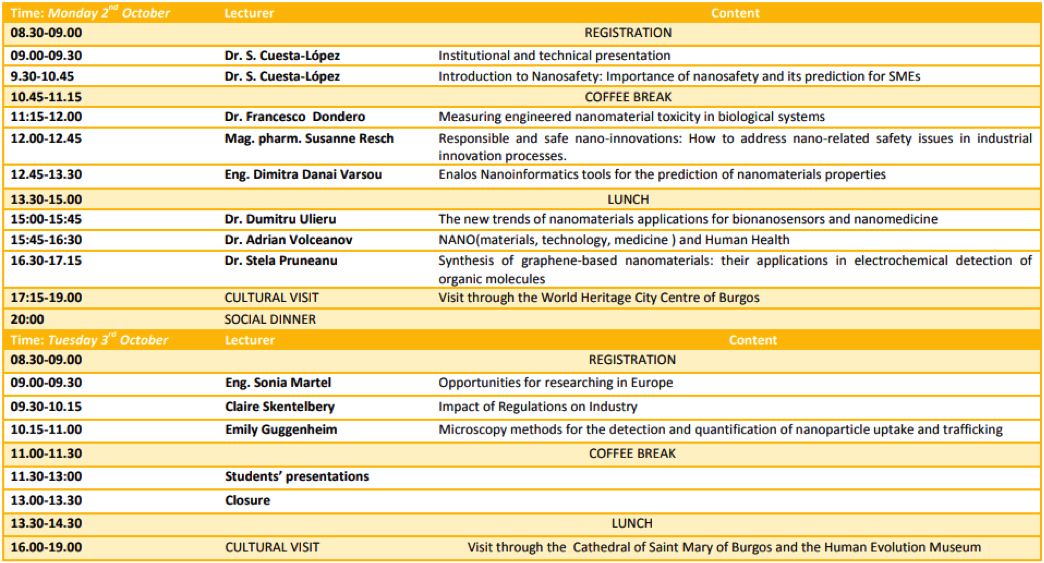
Poster Presentations
http://www3.ubu.es/iccram/nanogentools-eu-school/?page_id=160
Lecturers
| CLAIRE SKENTELBERY NIA General Director |
DIMITRA DANAI Chemical Engineer/Researcher at NovaMechanics Ltd. |
| ADRIAN VOLCEANOV Professor, Dept. Science & Engineering of Oxide Materials and Nanomaterials; Dean of the Faculty of Engineering in Foreign Languages |
FRANCESCO DONDERO Ecology Professor, Università del Piemonte Orientale Amedeo Avogadro, Vercelli Novara Alessandria |
| EMILY GUGGENHEIM Postdoctoral Researcher |
STELA PRUNEANU Senior Researcher- INCDTIM Cluj-Napoca |
| DUMITRU ULIERU R&D Director SITEX 45 SRL – Bucharest |
SUSANNE RESCH Scientist at BioNanoNet Forschungsgesellschaft mbH |
| SANTIAGO CUESTA Senior Researcher- ICCRAM-UBU |
|
Graphic Material
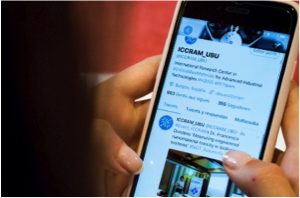
Photo Gallery:
http://www3.ubu.es/iccram/nanogentools-eu-school/?page_id=216
Video Gallery:
http://www3.ubu.es/iccram/nanogentools-eu-school/?page_id=313
Lectures
Conference Series: “Engineered nanomaterial interactions with ecological exudates – potential for impact on complex ecosystem signalling pathways”. Dr. Iseult Lynch
Aula Romeros – Universidad de Burgos, Jan 29th 2016, 11:30 h
Abstract: Nanoparticles (NPs) have a high surface energy that they seek to lower by binding to available biomolecules from their surroundings such as components of product formulations, proteins or lipids in living systems, natural organic matter (NOM) components of water or soil or potentially exuded and secreted biomolecules in complex ecosystems. Formation of a protein corona around NPs is a ubiquitous phenomenon that occurs instantaneously upon contact with available macromolecules. Most research to date has focussed on the interactions of NPs with blood proteins (human or animal sera) or lung surfactant proteins, to correlate corona composition with NP uptake and impacts on living systems. Environmental interactions research has focussed on NP-NOM interactions, assessing the impact of the humic substances on particle stability / bioavailability. Much less work has investigated the potential for NPs to bind the exuded biomolecules central to much of the plant and microorganism world, where secretion of biomolecules can be a defensive response to repel insect attack, or an offensive habit to repel other incompatible or competitive species.
Speaker: Dr. Iseult Lynch, University of Birmingham.
Senior Lecturer in Environmental Nanosciences (University of Birmingham). She has a very broad overview of all aspects of nanomaterials safety assessment and the dissemination requirements of different stakeholders, having served as theme editor for the Materials and classification section of the NanoSafety Cluster Vision 2015-2025 research roadmap (published June 2013). Prior to University of Brimingham, she was strategic research manager at the Centre for BioNano Interactions in University College Dublin, where she was instrumental in the development and implementation of the QualityNano research infrastructure.
Conference Series: “An integrative biology approach to nanomaterial effect assessment: a case study in marine molluscs”. Dr. Francesco Dondero
Aula Romeros – Universidad de Burgos, Jan 29th 2016, 12:30 h
Abstract: Nowadays the rapid increase in production and use of Engineered Nanomaterials (ENMs) is posing concerns on potential environmental hazard and risk. Therefore, the understanding of environmental fate, ecotoxicity and mechanism of action of ENMs is a high-priority task to safeguard ecosystems but also to support a safe-by-design approach from the industry.
Speaker: Senior Scientist at Department of Science and Technological Innovation (DiSIT), University of Piemonte Orientale, Alessandria, Italy. He has a broad experience in ecotoxicology: toxicity testing, data modeling, risk assessment, kinetics and toxico-dynamics of pollutants. He has more than 50 papers as author or co-author in international journals (H-index, 19), focusing recently on the environmental effects and risk of NMs. He is member of the Nanosafety Cluster and has contributed to the European booklet “Nanosafety in Europe 2015-2025: Towards Safe and Sustainable Nanomat. and Nanotech. Innovations”, which includes state of the art (SOA) and guidelines for future.
Nanosafety Cluster & EUON Data Sharing
The EU NanoSafety Cluster (NSC) face-to-face meeting and Data Harmonisation Workshop, which took place at the University of Birmingham’s Office in October 2018, comprised of two parts: a regular NSC face to face meeting in the morning of the first day, followed by the NSC and the European Chemicals Agency (ECHA) co-organised workshop on data harmonisation. The workshop aimed to bring together EU coordinators of current, recently completed and newly starting projects and other interested parties, including ECHA, to discuss nanosafety data. The afternoon of the first was dedicated to project specific presentations on strategies (past, present, future) for data capture, storage and archiving and data formats and was followed by an open discussion to understand what barriers may exist in data harmonisation and ways to overcome them.
The 2nd day involved an introduction of the EU project consensus view from the first day, followed by a presentation from ECHA on what is expected/needed for the EUON and workshop sessions discussing the main databases currently available and how their data can be harmonised across database capture systems (including consideration of SOPs), followed by discussion on database ontology harmonisation and requirements for transfer to the EUON. The aim of the workshop was to increase the NSC community’s ability to pool data, enhance data sharing and collaborations within the NSC and facilitate future data import into ECHA’s EU Observatory for Nanomaterials (EUON).
Executive Summary
Complete name of the event: NSC Face-to-Face Meeting and Data Harmonisation Workshop
Type of event: Meeting + Workshop
Dates: 18-19 October 2017 (Brussels)
Place: UoB Brussels office, Brussels, Belgium
Lead Organiser: UoB
Organizing Committee / Participants: NIA, Nanosafety Cluster, European Chemicals Agency (ECHA), EU Observatory for Nanomaterials (EUON)
Participation: Closed
Web:
Main Objetives
- Foster community interactions and provide support for different stakeholders
- Promote capture, preservation and dissemination of all publically- available NM measurement data
- Facilitate the (re-)use of existing data
- Identify specific milestones and pilot projects in relation to objectives 1-3
Agenda
NSC meeting & ECHA data harmonisation workshop
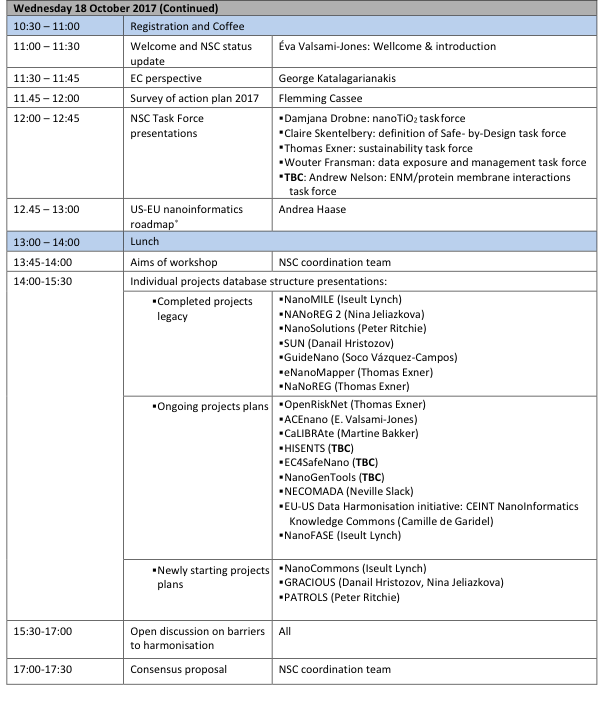
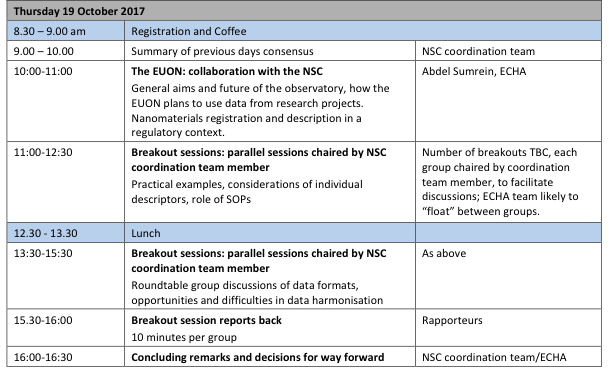
Bibliography
NSC Face-to-Face Meeting
NSC & ECHA Data Harmonisation Workshop
EU US Roadmap Nanoinformatics 2030
Driving Economic Development from Nanotechnology
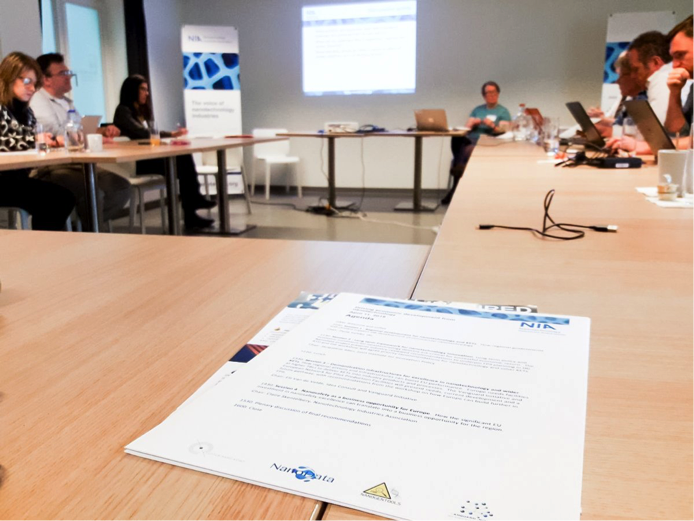
The aim of the workshop is to identify key requirements for the successful economic development of Key Enabling Technologies (KETs) and nanotechnology in Europe.
NIA is pleased to bring together projects and initiatives across Europe to address the topic of creating economic activity from nanotechnologies – with novel materials, safety and regional development- all key to building a thriving economic contributor.
Executive Summary
Complete name of the event: Driving economic development from nanotechnology
Type of event: Workshop
Date: 11 April 2018
Place: Brussels, Belgium
Lead Organiser:
Organizing Committee / Participants:
Participation: Limited, by form registration. Free entrance.
Target Groups: Actors involved in KETs, nanotechnology and support policies at regional, national and EU level.
Web:
Main Objetive
To provide a strong set of recommendations for all actors involved in supporting the development of nanotechnology as an economic activity within Europe.
Agenda
10.00: Welcome and coffee
11.00: Session 1 – Regional development for nanotechnology and KETs. How regional governments and clusters support the development of commercial nanotechnology
12.00: Lunch
13.00: Session 2 – Long term framework for nanotechnology innovation. Discuss the policy and economic conditions needed for nanotechnology delivery
14.00: Session 3 – Centres of excellence for nanotechnology and wider KETs. How regional actions and infrastructures can boost EU performance
15.00: Session 4 – Nanosafety as a business opportunity for Europe. How the significant EU investment in nanosafety excellence can translate into a business opportunity for the region.
16.00: Close
Graphic Material
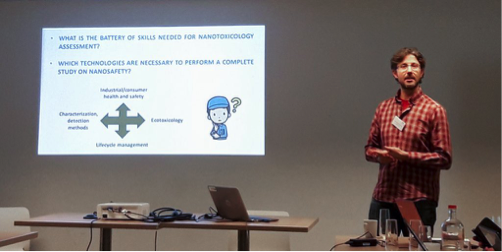
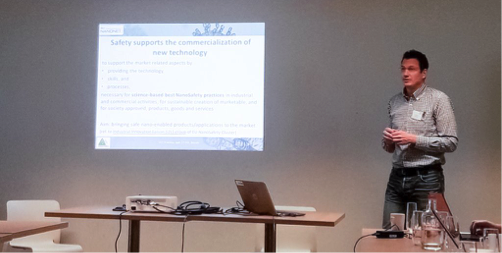
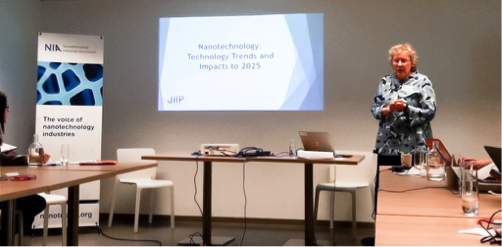
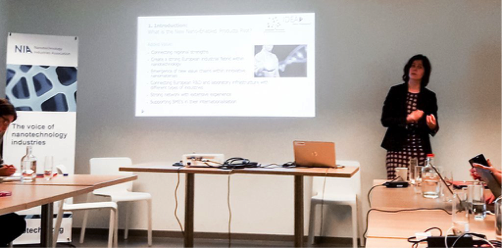
Bionano Interactions: Medical Breakthrough & Safety Aspects
Executive Summary
Complete name of the event: BioNanoNet Focus on Nanomedicine and Nanosafety: “Bio-Nano-Interactions: Medical Breakthrough & Safety Aspects“
Type of event: Training
Date: 12 September 2018
Place: JOANNEUM RESEARCH, Graz, Austria
Lead Organiser: BioNanoNet
Participation: Open. Paid
Web:
Agenda
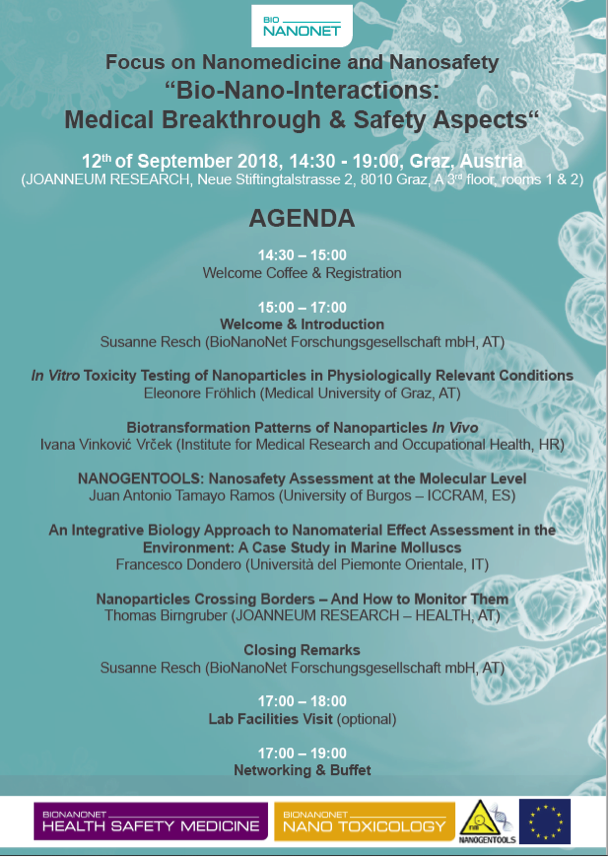
Graphic Material
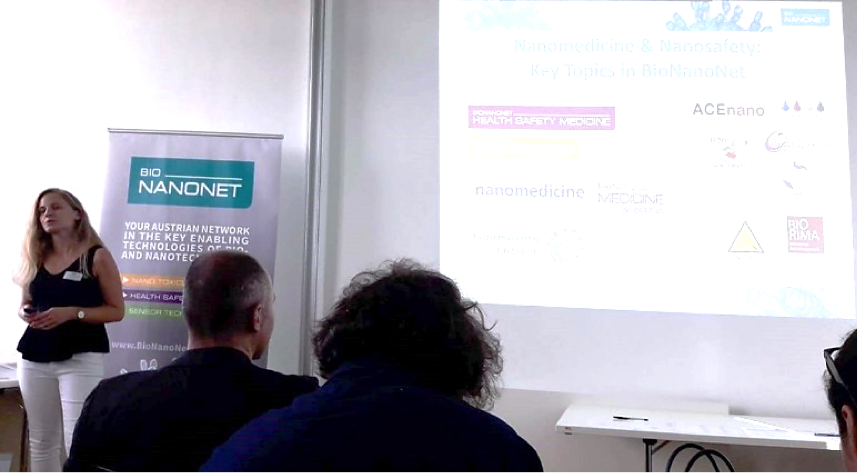
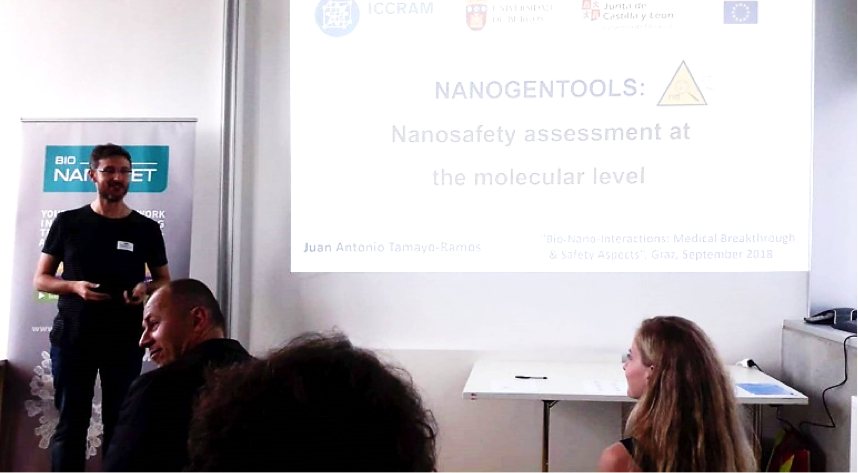
Multidisciplinary Cooperation In Research:
Nanotoxicology, Sensortechnology, Health, Safety and Nanomedicine
Executive Summary
Complete name of the event: BioNanoNet Strategic Development & Networking: “Multidisciplinary cooperation in research: nanotoxicology, sensortechnology, health-safety-medicine“
Type of event: Meeting & Networking
Date: 13 September 2018
Place: University of Graz, Graz, Austria
Lead Organiser: BioNanoNet
Participation: Open. Paid
Web:
Agenda
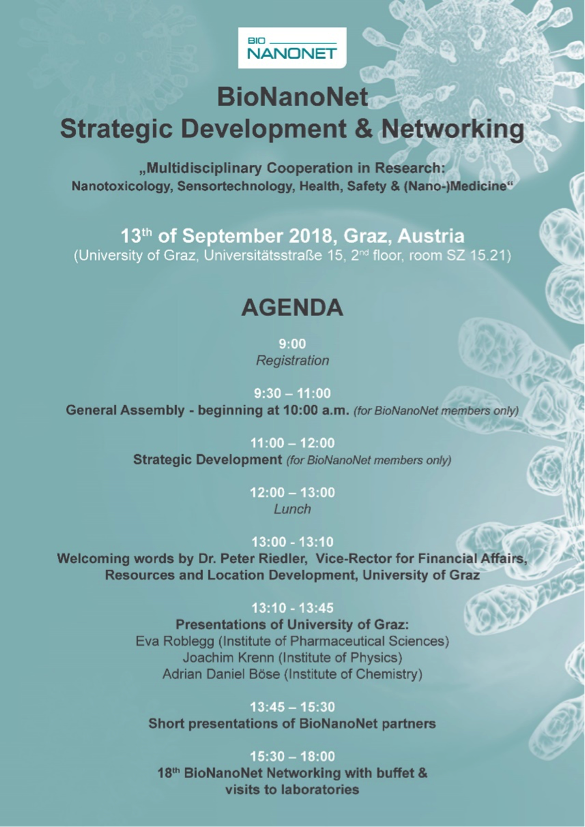
Graphic Material
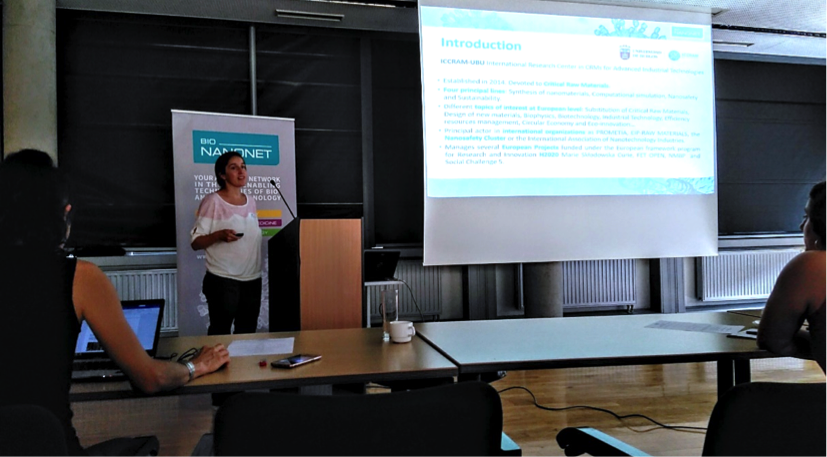
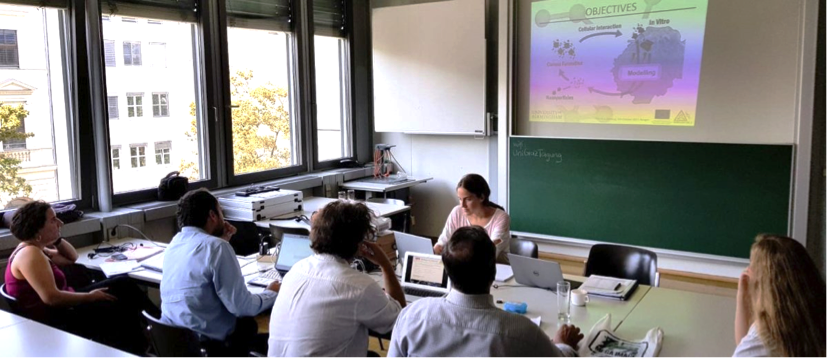
Nano-Enabled Sensing Systems
Executive Summary
Complete name of the event: BioNanoNet Focus on Sensortechnology: “Nano-enabled sensing systems“
Type of event: Training
Date: 14 September 2018
Place: University of Graz, Graz, Austria
Lead Organiser: BioNanoNet
Participation: Open. Paid
Web:
Agenda
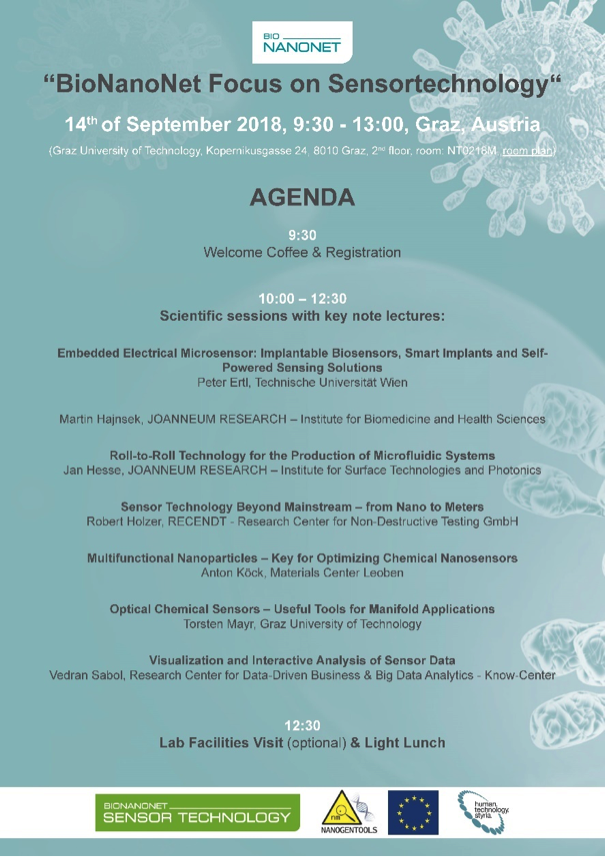
Graphic Material
Final Spring School

The Spring School is a 3-day meeting which will include keynotes and presentations by international experts in the nanomaterials field, involved in European-level research projects (NANOGENTOOLS, NANOCOMMONS, SOLUTION and THE GRAPHENE FLAGSHIP) and organisms (EU-Nanosafety Cluster and REACH) addressing applications, safety and regulatory aspects of nanoparticles.
A workshop that allows knowledge exchange between various SbD projects as well as listening and learning from different stakeholder groups (industry, academia, regulators, insurance, consumers) can help adjusting research, dissemination and exploitation strategies accordingly.
The Spring School is aimed to give PhD students and other young researchers a comprehensive overview of theoretical, practical, and technological issues related to the overarching legislation, toxicology assessment and current applications of nanomaterials.
Students had free registration to the meeting that includes all meals, and will they only had to pay for their travel and accommodation.
Executive Summary
Complete name of the event: Applications And Safety Assessment Of Nanomaterials: New Technological Approaches And Regulatory Aspects
Type of event: Workshop
Dates: 22-24 May 2019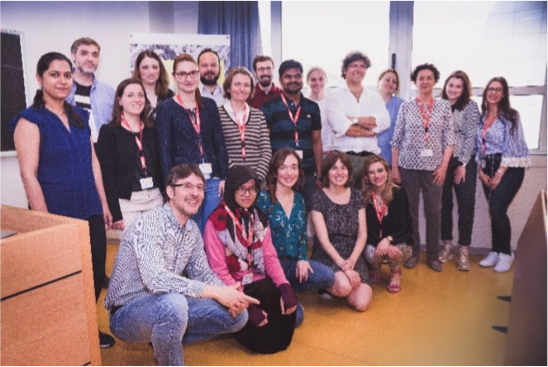
Place: Università degli Studi del Piemonte Orientale “Amedeo Avogadro” | Piemonte, Alessandria, Italy
Lead Organiser: ICCRAM-UBU, UPO
Organizing Committee / Participants: ICCRAM-UBU, DISIT-UPO, INCDITIM, IBMC, UNISTRA, LIST, Novamechanics, FORTH, BNN, NIA, SITEX45, UoB
Participation: Limited, by form registration. Free entrance.
Web:
Agenda
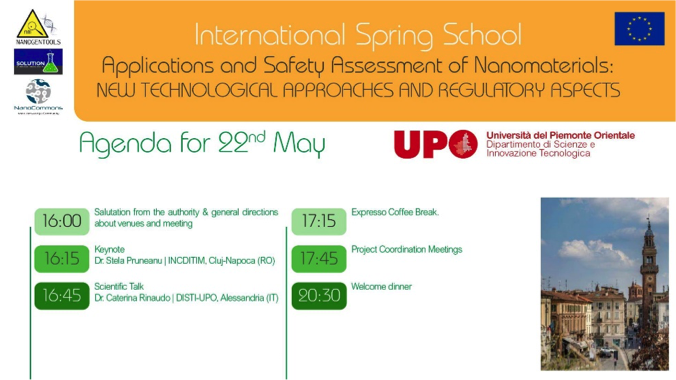
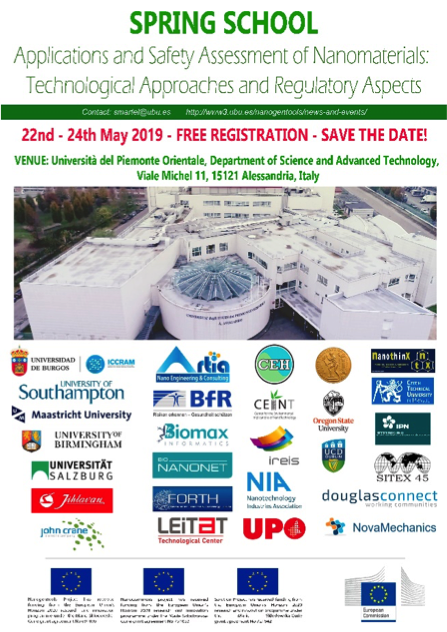
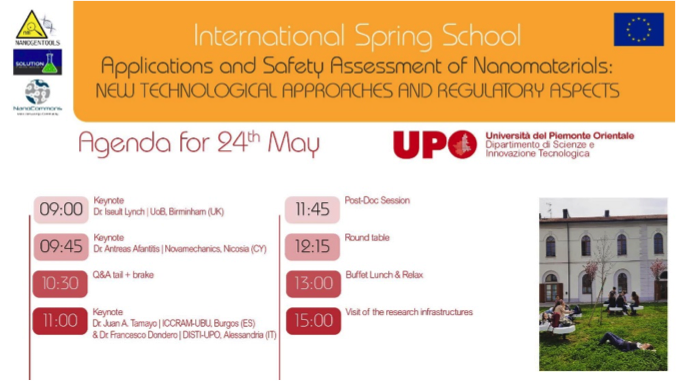
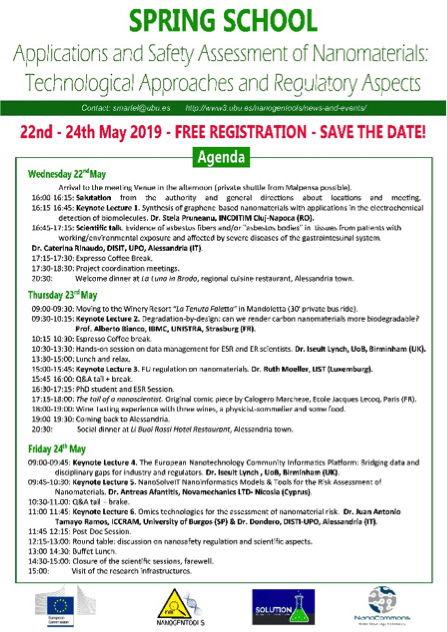
Save the Date
Lecturers
| Dr. Juan Antonio Tamayo (ICCRAM-UBU) PhD in Molecular Microbiology |
Brixhilda Domi (ICCRAM-UBU) PhD Student |
| Dr. Francesco Dondero (DiSIT-UPO) Senior Scientist and Ecology Professor |
Loukia Maritsa (ICCRAM-UBU) PhD Student |
| Dr. Ruth Moeller (LIST) MSc in Toxicology |
Altifani Rizky (FMIPA) PhD Student |
| Dr. Anastasios Papadiamantis (UoB) BSc in Physics & MSc in “Optics and Vision” |
Elisa Moschini (LIST) PhD Student |
| Dr. Caterina Rinaudo (DiSIT-UPO) Associate Professor of Mineralogy |
Candida Lorusso (DiSIT-UPO) PhD Student |
| Dr. Alberto Bianco (IBMC-UNISTRA) Research Director at the CNRS & member of Graphene Flagship |
Valerio Giugliano (DIRECTA PLUS) |
| Dr. Antreas Afantitis (NovaMechanics) PhD-MBA & director of NovaMechanics |
Carlo Stafforini (IDRECO) |
| Dr. Stela Pruneanu (INCDTIM) PhD in Chemistry-Physics |
Social Networks Activity
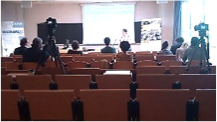 Twitter ⚡️ https://t.co/JJZh01N9JH | 14 Posts, >11.200 Reach
Twitter ⚡️ https://t.co/JJZh01N9JH | 14 Posts, >11.200 Reach
Facebook 🗓 facebook.com/events/396909167526651 | 12 Posts, >2.000 Reach
Session Topics
Interviews
Senior researchers give an overview of the workshop content through short interviews with participant lecturers, to create awareness and engagement among the students and provide a general overview of the topic.
Lectures
- Alberto Bianco, IBMC-UNISTRA
- Stela Pruneanu, INCDTIM
- Ruth Moeller, LIST
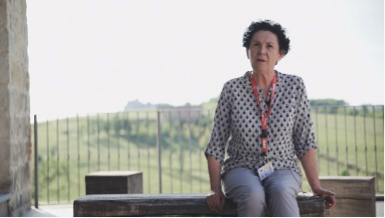
Students Session
PhD Students give a presentation of their research areas and results obtained during their thesis development and their career experience.
Lectures
- Brixhilda Domi, ICCRAM-UBU
- Loukia Maritsa, ICCRAM-UBU
- Altifani Rizky, FMIPA Universitas Indonesia
- Elisa Moschini, LIST
- Candida Lorusso, DiSIT-UPO
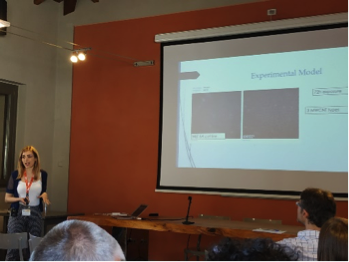
Synthesis of nanomaterials and applications
Different existing processes for the production of graphene nanoparticles. Fabrication of graphene is done through different synthesis approaches, including mechanical exfoliation from graphite, chemical vapor deposition, and reduction of graphene oxide through heating. The properties of graphene will depend on the fabrication process, which will influence as well its potential applications and biodegradability. The main objetive is to understand how graphene-based nanomaterials can be synthetized and some of its applications, & to understand new advanced techniques and methods to reach the biodegradability of carbon-based nanomaterials.
Lectures
- Synthesis of graphene-based nanomaterials with applications in the electrochemical detection of biomolecules (Dr. Stela Pruneanu, INCDTIM)
- Degradation-by-design to render carbon nanomaterials more biodegradable.
( Alberto Bianco, IBMC-UNISTRA)
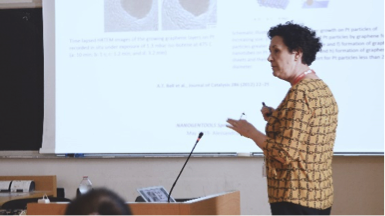
European Union regulation on nanomaterials
European Union regulatory procedures for risk management of nanomaterials. Existing frameworks for nanomaterials risk management were described in detail. Concepts, such as the European Commission´s regulatory definition of what is a nanomaterial, the revision of REACH annexes on information requirements for nanomaterials´ registration, and transparency measures to put in place to improve EU-wide information on nanomaterials will be introduced. Also, related specific REACH and CLP regulations will be explained, to have a clear view of the regulatory framework at a European Level regarding nanomaterials and how it must be addressed for innovation.
Lecture
Nanomaterials in REACH and CLP. (Dr. Ruth Moeller, LIST)
Safety assessment of nanomaterials
Focus on the toxicology assessment of nanomaterials. In particular, approaches and methodologies developed to understand the molecular basis of how nanoparticles can disrupt different biological targets will be explained (mechanistic toxicology). In addition, specific toxicology concepts associated to the specific physico-chemical properties of nanomaterials (surface reactivity, protein corona formation, etc.) and their relevance, understanding different approaches to assess the safety of the materials.
Lectures
- Omics technologies for the assessment of nanomaterial risk. Applications on human cell lines. ( Francesco Dondero, DiSIT-UPO)
- Omics technologies for the assessment of nanomaterial risk. Applications on the model fungus Saccharomyces cerevisiae. ( Juan Antonio Tamayo, ICCRAM-UBU)
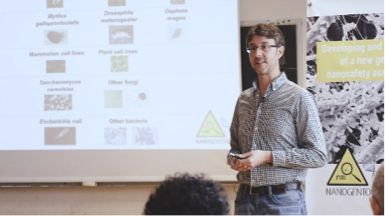
Nanoparticles toxicity: a case study
Practical case study on nanoparticles toxicity, related to the population exposure to asbestos and its consequences. The nature and contemporary applications of the naturally occurring fibrous minerals will be explained. Examples of primary asbestos exposure, of workers with professional activities related to asbestos mining and industrial processing, as well as secondary exposure, when fibers released to the air are inhaled by persons not directly handling asbestos, will be given. Also, exposure related illnesses and well as methodologies to assess the accumulation of asbestos fibers in different human tissues will be shown. The aim of this topic is to realize about the different properties and characteristics that can enhance the toxicity of the materials.
Lecture
- Evidence of asbestos fibers and/or “asbestos bodies” in tissues from patients with working/environmental exposure and affected by severe diseases of the gastrointestinal system. (Dr. Caterina Rinaudo, DiSIT-UPO)

Data management for risk assessment of nanomaterials
European Nanotechnology Community Informatics Platform (Nanocommons), and its efforts towards the integration, consolidation, annotation and facilitated access to the disparate datasets produced by different scientific projects performing research on nanosafety assessment. Secondly, it will introduce the ground-breaking in silico Integrated Approach to Testing and Assessment (IATA) for the environmental health and safety assessment of nanomaterials (ENM), provided by the H2020 project NanoSolveIT, and finally, an introduction to data management for scientists using the open access-web application SciNote. Assistants had learnt how to manage the information generated in research related to nanomaterials, how to integrate it in European Platforms and how to use these platforms for nanosafety studies.
Lectures
- The European Nanotechnology Community Informatics Platform: Bridging data and disciplinary gaps for industry and regulators. (Dr. Anastasios Papadiamantis, UoB)
- NanoSolveIT Nanoinformatics Models & Tools for the Risk Assessment of Nanomaterials.
(Dr. Antreas Afantitis, NovaMechanics) - Hands-on session on data management for scientists. (Dr. Anastasios Papadiamantis, UoB

Industrial Activity in Nanomaterials
Industry enterprises present their business involved in nanomaterials market, and explaining their expertise field and how they can contribute to european projects and its applications in real world.
Lectures
- Valerio Giugliano, DIRECTA PLUS
- Carlo Stafforini, IDRECO


